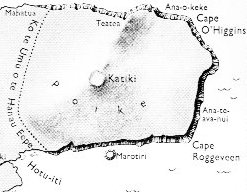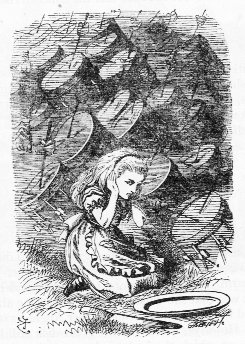Maunga Teatea was a place where the journey of the kuhane changed direction from going withershins (like the white Moon) to following the young red Sun from east to west. The returning light of the Sun could here have enabled the kuhane to see in the distance (ho! - ho! - ho!).
 Maunga Teatea was the central peak in the triplet lined up northeast of Katiki, in a way reflecting the triplet of islets in the southwest, where therer were 3 'young men' standing in the water:
 ... On the following day, 20 November 1770, Commander JosÚ Bustillo took formal possession of Easter Island 'in the name of the King and of Spain, our Lord and Master Don Carlos the third', renaming the island 'San Carlos'. Several hundred Rapanui - probably members of the Koro 'o 'Orongo tribe of the eastern 'Otu 'Iti - observed the ceremony not far from Poike's parasitic cones Parehe, Teatea, and Vai 'a Heva, on the tops of which the Spaniards had planted three crosses. Following three boisterous 'Viva el Rey!' for each cross, the land party let off three salvos of musketry, whereupon the two Spanish vessels San Lorenzo and Santa Rosalia responded with 21 cannon salutes. Spain's foremost historian of the Pacific, Francisco MellÚn Blanco, has written of the event: 'The spectacle must have been awe-inspiring for the islanders. The parade of uniformed soldiers; the fluttering flags; the chaplains in their surplices chanting out the litany; the beating of drums, and the trilling of fifes must have left a lasting impression on all the natives who witnessed the procession' ... ... 3 * 3 = 9 musketry salvos ought to mean the end of the previous reign (even a cat has no more than 9 lives). The following salute from the pair of ships with 21 cannon shots - one more than 20 - was to indicate the beginning of something new. The beating of drums and other noise, and the ceremonies, were there to wake up this new era ... The ruling king of the land should represent the Sun and he was reborn in the northeast. Down in the southwestern corner of the island there were 3 islets followed by Rano Kau and in the northeastern corner was Pua Katiki followed by 3 mountain peaks. Katiki. Halo (of sun, of moon). Vanaga. Certainly this symmetric arrangement must have had a place is the mythic timespace of Easter Island.
|
